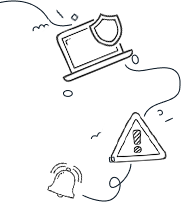Introduction
So, what exactly happens when cybercriminals gain control of your devices? It’s not like they’ll call you up for a coffee date or send you a friendly text! Whether they waltz in through malware, phishing, or some other shady door, they can ultimately hijack your gadget. In some cases, they might even recruit your device into their botnet. Sounds like the start of a sci-fi movie, doesn’t it?
But what is this cyber-menace, and how can you ensure your systems don’t end up as unwitting extras in the next botnet blockbuster?
What are Botnets and How Do They Work?
Once your device gets infected, it’s like joining a cult you never signed up for! Cybercriminals will “recruit” it into their army of remote-controlled gadgets. Imagine, other phones and computers just like yours, transformed into digital zombies for their nefarious schemes. Yikes!
These botnets enlist your devices to unleash DDOS attacks on poor websites—basically overwhelming their servers with traffic until they crash, like a bad concert where everyone rushes the stage. Some botnets might even transform your trusty email into a spam factory, bombarding your contacts with ludicrous messages about “amazing discounts” that you didn’t write (but, boy, do you wish you’d invented that kind of creativity!). And with complete control over your system, these digital villains can swipe your personal information, from login details to bank accounts. If that wasn’t enough, they might even use your device’s power for crypto-mining! You’ll be left wondering why your device is running slower than a snail on a treadmill, and why your electric bill has suddenly become more frightening than a horror movie.
So, what can this look like on your devices? You might be dealing with a sluggish phone, mind-boggling charges on your next bill, or even a hacked account. Nobody wants their smart TV sending out scam emails or secretly mining Bitcoin while you’re binge-watching your favorite series!
How to Spot Botnets on Your Device
Your gadgets won’t start groaning like zombies (we’re not living in a horror flick after all), but there are clues you should watch out for:
- Your phone or computer suddenly moves slower than molasses on a cold winter day, even when you haven’t asked it to do anything remotely strenuous.
- The internet starts acting quirky, with random pop-ups, or using unusual amounts of CPU and data—as if it’s throwing a digital tantrum.
- Your device feels like it’s boiling hot, and the fan sounds like it’s about to take off into space.
- Your system crashes more often than a clumsy waiter carrying a tray full of dishes.
- Contacts reach out, saying they’ve received spam from your email or have spotted bizarre posts on your social media. Oops!
While botnets sound like something out of a tech horror story, recognizing these signs quickly can lead you to take action before it’s too late. Like spotting a spider at the edge of your bath—you don’t want to wait too long!
Protecting Your Devices with Cyber Hygiene
Cyber hygiene is more like your everyday practices that keep your devices safe instead of grimy. Adding a few smart habits to your daily routines can help fend off botnets and other cybersecurity monsters lurking in the shadows.
Here are a few simple tips to strengthen your digital fortress:
- Regularly update your phone, computer, and apps. Think of it as their version of going to the gym!
- Create strong, unique passwords for each account and your Wi-Fi, because “123456” simply won’t cut it anymore.
- Enable multi-factor authentication wherever possible. Think of it as adding extra locks to your doors—better safe than sorry!
- Change the default credentials on your Wi-Fi and devices; don’t let cybercriminals waltz in through the front door.
- If your trusted antivirus says something is dangerous, take it seriously. It’s not just being overdramatic!
- Avoid clicking on suspicious links or downloads—think of them like a mysterious van offering free candy; it’s best to steer clear!
With these savvy suggestions, your devices stand a much better chance of resisting unwanted botnet invitations.
Recent Charges Against a State-Sponsored Botnet Group
In late May 2025, the United States Department of Justice charged 16 individuals in a botnet group allegedly tied to Russia, known as DanaBot. The charges claim they compromised at least 300K devices worldwide. Talk about a busy day at the cybercrime office!
As the group appears to be state-sponsored, this incident has raised alarm bells regarding the intertwining of cybercrime and geopolitical tensions. It’s a little like mixing business with pleasure, and the consequences could be catastrophic.
DanaBot serves as a reminder of the growing threat posed by nation-state cyberattacks. Many experts view incidents like these as a call to arms for international cooperation in cybersecurity—because let’s be honest, who wants to find themselves on the receiving end of government-backed hacking?
Conclusion
Botnets can create quite the mess, both for the unfortunate souls who fall victim to these attacks and for the innocent devices unwittingly swept up in the chaos. On the bright side, being aware of the telltale signs and taking proactive steps can significantly reduce your risk of becoming a botnet soldier.
As we live in a world where we’re constantly connected, staying alert is more crucial than ever. By understanding how botnets operate, recognizing the warning signs, and taking preventive action, you’re not only protecting your own devices but also helping to create a safer digital realm for everyone.
Stay informed, stay secure, and for goodness’ sake, don’t let your technology become an unwitting accomplice in cybercrime!
The post When Botnets Take Over Your Phone appeared first on Cybersafe.




